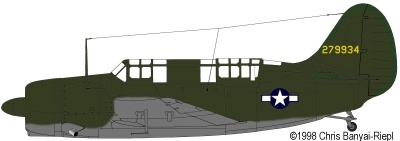This site is best
viewed at 800x600
and 16 bit color.
 |  |
| Curtiss A-25 Shrike of the 406th Fighter Group in South Carolina. This A-25 was used as a target tug. | This is an addition to Tom Cleaver's original Helldiver article, which can be found here. |
HELLDIVER UPDATE - DOING THEM REALLY RIGHTByThomas McKelvey CleaverWith the publication of Barrett Tillman's "Helldiver Units Of World War 2" in the Osprey series, there are fare more photographs of SB2C Helldivers than I had previously run across, plus Barrett's meticulous documentation of what versions were used when. With this, the modeller has everything needed to make modified Helldivers that are really right. The SB2C-1CThe big thing I noticed in the photos of SB2C-1s was that I was incorrect in calling for the cuffed Curtiss-Electric propeller from the Monogram P-47 as an element of the conversion. What I used in modifying my model was an old Arii F4U Corsair prop, cut one-quarter inch short at the hub, with the blades cleaned up. Frankly, there are other props that would do it, but this one seems to have the right shape eyeballing it off the page. Use this prop as instructed in my previous article, and you will have an accurate-looking SB2C-1. As an historical note, if you want to model a Helldiver from the "Mission Beyond Darkness," you want to do the SB2C-1C, as all units that took part in the First Battle of the Phillipine Sea (to give it its official name) were equipped with the SB2C-1C. The A-25 ShrikeThe A-25 bears the same relationship to the SB2C as the A-24 does to the SBD; both were the USAAF's attempt to adapt an off-the-shelf divebomber for the tactical role, and both were equally-unsuccessful in USAAF service. The A-25 is basically the SB2C-1 with the wing armament of four .50 caliber machine guns. The rear gunner was equipped with a single .50 caliber weapon. To model this aircraft, follow the instructions for the SB2C-1C, with the change of taking off the 20mm cannons. Use a .50 caliber waist gun from a Monogram B-26 Marauder (if you close the waist hatches on the model - as they usually were except when under fire, you can't see the guns anyway)and otherwise assemble the rear turret per the kit instructions. The aircraft would be camouflaged olive drab/neutral grey, and would use the late 1942/early 1943 star without bars national insignia. Operationally, the A-25s never saw first line service with anyone - the Marines got a couple hundred fobbed off on them, which they used for training; Marine aviators I know who flew them say they were even worse than the normal Helldiver. The SB2C-3The SB2C-3 is the easiest conversion of all from the Pro-Modeller kit. The early production version is exactly like the conversion for the SB2C-1C in my previous article, with the exception that the 4-blade prop provided in the kit is used, without the spinner; you will want to do the "solid" dive brakes. The later production version of the SB2C-3 is the P-M kit without rocket rails underwing, and no spinner hub. All SB2C-3s saw combat in the tri-color camouflage scheme. The main fleet action the SB2C-3 participated in was the Second Battle of the Phillipine Sea in October 1944. Dropping Flaps On HelldiversA lot of people have thought that dropping the flaps on the Helldiver kit was simply a matter of lowering the lower surface. As is pointed out in "SB2C In Detail And Scale," however, the inner structure of the dive brakes prevents this. I had worked out a method for dropping the flaps for the SB2C-1C and early SB2C-3 with "solid" flaps; I have recently heard from my friend David Batt in England, that the method works equally well for the perforated flaps. Here it is: Cut off the inner dive brake structures from the wings prior to assembly. "Flip" them, i.e., upper right becomes upper left, with the detailed structure inside rather than outside, etc., and sand them thinner. Attach this structure to the interior of the particular dive brake, either the solid one you've made from plastic sheet or the kit-provided perforated dive brake. If you're doing the perforated flap, drill out the larger holes in the plastic inner structure. Be sure if you are using the perforated flap to paint both sides of the inner structure red before assembly. Only the lower surfaces should be moved, as the upper surfaces were only raised when the aircraft entered a dive. Aftermarket ConversionsKendall has released a cast resin conversion set for the SB2C that includes a new cockpit interior for both pilot and gunner, and the necessary structure to fold the wings. My friend David Batt, who is doing this conversion for an article in "Scale Aircraft Modeller International" informs me that based on his experience, he would not use the cockpit interiors on a model with the wings folded, as the folded wings effectively block almost all view of the coockpits. He also tells me that the wing-fold is easy to do and looks quite impressive when finished. You can confirm this from his article which should be in the next issue of the magazine. Aeromaster has two sheets of aftermarket decals out for the Helldiver. Be alert that there is far more to the SB2C-5 conversion than merely changing the pilot's canopy, as they instruct. But then, you downloaded my previous article, so you know all you need to know about the -5, right? Research MaterialAs I stated in my review of "Helldiver Units Of World War 2," do not use the color profiles for anything but marking information, and beware that several aircraft identified in the profile section as SB2C-3s are correctly identified in photos as SB2C-4s. The drawings in back are quite accurate, and I would use those as guides for conversions to the earlier types. The "SB2C In Detail And Scale" book is worth every penny for detail information. The Squadron-Signal book is about as good as that series gets, which means you should check the information there with other sources. Have fun. You now have all the information you need to make all the models you want of the worst dive bomber ever to see action. | |